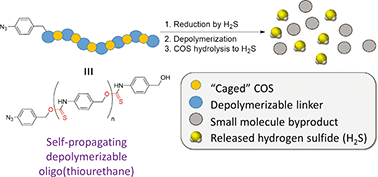Self-amplified depolymerization of oligo(thiourethanes) for the release of COS/H2S†
Abstract
Herein we report the self-amplified depolymerization of an aryl oligo(thiourethane) (OTU) for the release of COS/H2S. The OTU was synthesized via polyaddition of 4-isothiocyanatobenzyl alcohol and end-capped with an aryl azide. The aryl azide chain-end was reduced by tris(2-carboxyethyl)phosphine or H2S to the corresponding aniline, resulting in depolymerization (i.e., self-immolation) and the release of COS/H2S. Depolymerization was monitored by 1H NMR and UV-Vis spectroscopy, and the released COS was converted into H2S by the ubiquitous enzyme carbonic anhydrase in aqueous media, generating an amplified response.

- This article is part of the themed collection: Pioneering Investigators


 Please wait while we load your content...
Please wait while we load your content...